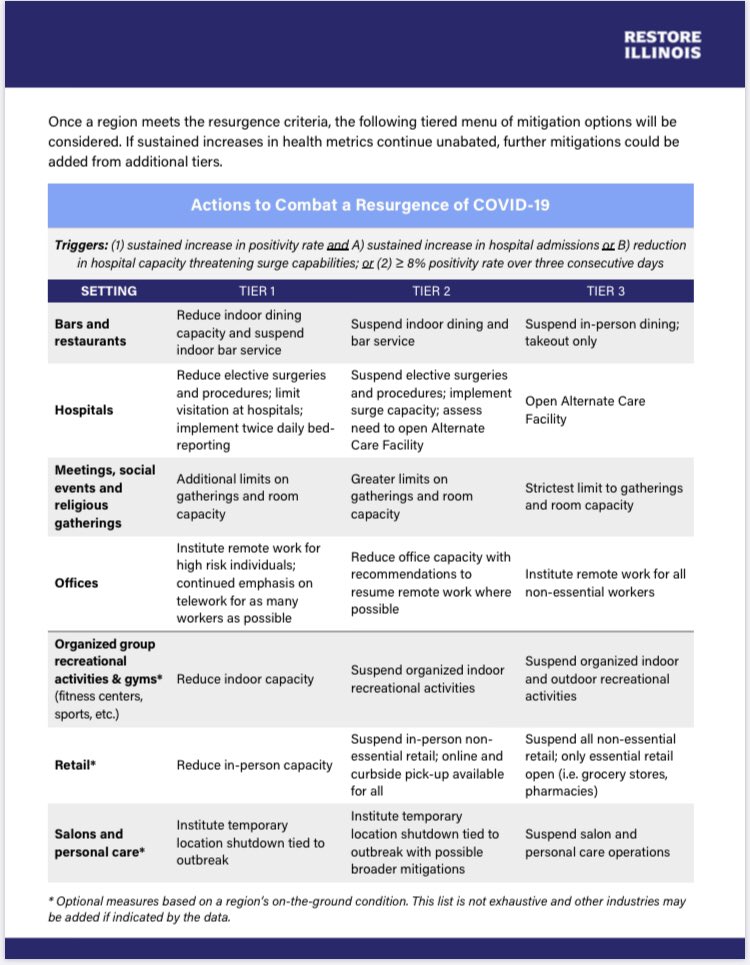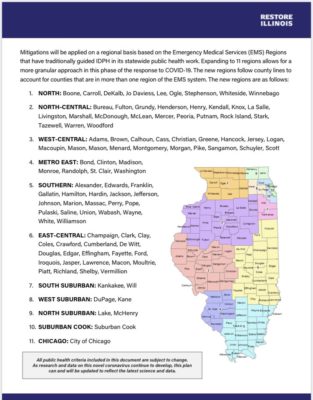Governor J.B. Pritzker announced a new plan to mitigate COVID-19 outbreaks in the state. Pritzker says that the state is an outlier in the country because of a low rate of hospitalization, low rates of positive cases, and having one of the most robust systems of testing in the country.
Pritzker says he doesn’t want to discourage people from traveling out of state but says there is a nearly doubled risk of infection if you pass out of Illinois’ borders: “When you look at areas like St Clair County and Madison County right across the river from St. Louis. Missouri has a, I forget the exact number for Missouri, but I think it’s around a 7% positivity rate. Ours is three. So, if you live in that area and you’re traveling across the bridge to Missouri, you’re essentially doubling the possibility that you could contract this, or at least the number of people that you’re end up in front of [has the virus]. It’s very important for people who live in those areas to be aware of following mitigations that we’ve suggested in Illinois, even if it isn’t required in the state that you are going into. You want to protect yourself certainly, and you hope people there will be protecting you.”
The Illinois Department of Public Health will now use a new system of metrics to determine outbreaks and will now divide the state from 4 service regions into the state’s 11 EMS regions with only minor modifications. Pritzker says that if certain metrics rise that the state will respond: “It’s important that when we see trends in our data that indicate a potential problem in any region of Illinois that we need to start tightening mitigations in that region before it’s too late. The epidemiologists and professionals at IDPH have determined that we need to take action in a region if we see a sustained rise in the positivity rate along with either a sustained increase in COVID-19 hospital admissions or a reduction in hospital surge capacities.”
The following metrics will be used to determine when the spread of the virus in a region requires additional mitigations:
* Sustained increase in 7-day rolling average (7 out of 10 days) in the positivity rate and one of the following severity indicators:
a) Sustained 7-day increase in hospital admissions for a COVID-19 like illness
b) Reduction in hospital capacity threatening surge capabilities (ICU capacity or medical/surgical beds < 20%)
* OR three consecutive days averaging ≥ 8% positivity rate

Adams, Brown, Calhoun, Cass, Christian, Greene, Hancock, Jersey, Logan, Macoupin, Mason, Mason, Menard, Montgomery, Morgan, Pike, Sangamon, Schuyler, Scott make up Region #3 also called the West Central region.
Over the next week, 26 local health departments are earmarked to receive additional funding from the state, representing over $127 million of available grant funds for contact tracing efforts. With these funds, local health departments are expected to hire approximately 1,330 contact tracers over the next few months and significantly expand their contact tracing efforts. IDPH also announced that the state has now surpassed over 2 million tests, which requires the need of expanding the contact tracing program.
IDPH Director Dr. Ngozi Ezike says no one asked for a global pandemic to upend what’s normal behavior, and effectively cancel our summer. She says the coronavirus persists without a vaccine, and now is the time to continue personal mitigation efforts: “Yes, we stayed home initially and made it very hard for the virus to find people to infect. That was so key, and that’s why we are sitting on the success that we have. That’s why we have the lowest positivity rates for any states in our region. The deal was that as we go out and try to get back to some level of normalcy that we would have the mitigation strategies in place: the face covering, washing our hands, and watching our distance.”
Ezike says there needs to be a large uptick in people using those strategies to prevent spread of the virus. Ezike says that the current older population has done well, and that long-term care facilities have improved mitigation efforts but a certain demographic in the state has seen a larger number of cases: “In the recent weeks we have seen that the 20 to 29 [demographic] and again we have so much data when you break it out, it might be the case for, I think, non Hispanic whites 20 to 29 [demographic]. That’s the largest group [that’s seen the most cases]. Then, you also had that [rise] in Blacks 20 to 29; but then you just you’ve never seen this high rate for the 10 to 19 [deomgraphic], that is new in terms of the numbers climbing over time. They’re now at the highest rate that they’ve ever had from the beginning of this pandemic.”
Ezike says that thanks to those who have been adherent to the mitigation efforts the state has some of the lowest rates in country. However, she says the state needs more support of the mitigation efforts in order to fiercely guard the success seen in Illinois so far.




